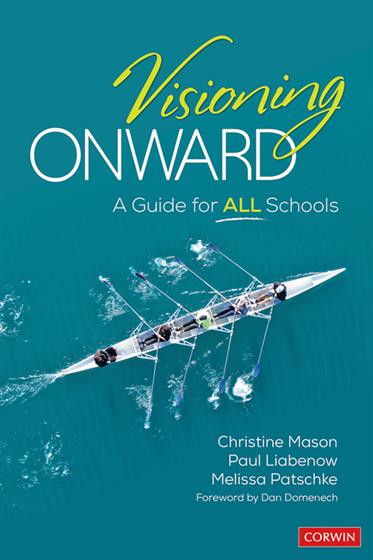Hands-on, Practical Guidance for Educators
From math,
literacy, equity, multilingual learners, and SEL, to assessment, school counseling,
and education leadership, our books are research-based and authored by experts
on topics most relevant to what educators are facing today.

Visioning Onward
Foreword by Daniel A. Domenech, Executive Director of AASA
Envision and enact transformative change with an iterative visioning process, thought-provoking vignettes, case studies from exemplary schools, key strategies and tools, and practical implementation ideas.
- Grade Level: PreK-12
- ISBN: 9781071800157
- Published By: Corwin
- Year: 2020
- Page Count: 264
- Publication date: February 07, 2020
Review Copies
Review copies may be requested by individuals planning to purchase 10 or more copies for a team or considering a book for adoption in a higher ed course. Request review copy - opens in a new tab - opens in a new tab
Description
The step-by-step guide to defining your vision—and making it reality
As a leader, it’s your job to look beyond the present and envision a brighter future for your school. Choosing the right path, however, can be a challenge.
This inspirational resource is your guide. By following its one-of-a-kind iterative visioning process, you’ll sharpen your vision into a road map for transformative change—tailored to the needs of your learning community. Features include:
- Key strategies and tools for building a shared vision
- Practical implementation ideas
- Case studies from exemplary schools
- Common trends at the heart of impactful, positive change
- Thought-provoking vignettes
Turn vision into reality, possibilities into plans, and create an environment that strengthens engagement, provides safe and nurturing learning opportunities, and produces students with the skills, knowledge, and disposition to be successful in life.
Author(s)

Christine Mason
Christine Mason, PhD, an educational psychologist, is a nationally recognized expert in the areas of educational reform, visioning, trauma and mindfulness, teacher and principal mentoring, and special education. She is also a yoga, mindfulness, meditation instructor who was trained in New Mexico and certified in 2001, with a Level II yoga certification in Conscious Communication in 2005. From 2005-2009, she was chair of the Education Committee for Miri Piri Academy, an international yoga boarding school in Amritsar, India. In 2009, she served for 5 months as the interim principal at Miri Piri. Since being certified to teach yoga, Christine has taught 2-5 yoga and meditation classes weekly in local community centers and for the Fairfax County Parks and Recreation program. She is a member of the International Kundalini Yoga Teachers Association and is also certified in Radiant Child Yoga.
Christine is the Founder and Executive Director of the Center for Educational Improvement, an intentional collaborative of educators and researchers actively engaging to create a transformational system of education focused on collective healing and holistic learning. We identify, curate, develop, and scale-up sustainable practices, such as Heart Centered Learning and Leadership and student-led reform, that nurture family and community connectedness, well-being, equity, and justice.
Christine is also the Chief Advisor to the Childhood-Trauma Learning Collaborative, with Yale University’s New England Mental Health Technology Transfer Center. Her time as chair of Miri Piri’s education committee and her multiple visits to India, as well as her experiences networking for transformative educational change and researching exemplary educational programs, serve as the foundation for her beliefs and efforts to bring compassionate practices to all aspects of education.
Early in her career, Christine also was a classroom teacher and a professor, teaching courses in curriculum, inclusion, social emotional learning, educational assessment, and educational research. She has also served as Associate Executive Director of Research and Professional Development at the National Association of Elementary School Principals (NAESP); Director of Professional Development for the Student Support Center in Washington, D.C.; and the Senior Director for Research and Development with the Council for Exceptional Children. Christine is lead author of several books and articles, including Mindfulness Practices: Cultivating Heart Centered Communities Where Children Focus and Flourish, Mindful School Communities: The 5 Cs of Nurturing Heart Centered Learning, Visioning Onward: A Guide for ALL Schools, and Compassionate School Practices: Fostering Children’s Mental Health and Well-Being. She is also the primary author and developer of an innovative process for developing compassionate school cultures: The School Compassionate Culture Analytical Tool for Educators (S-CCATE).

Paul Liabenow
Paul Liabenow, Executive Director
Principal Mentoring: MEMSPA and the NAESP
The Michigan Elementary Middle School Principals Association (MEMSPA) is currently offering members personal mentoring and professional learning programs as member benefits. Several years ago, MEMSPA realized that its services were being used primarily by white school principals in schools that were also largely white. As executive director, Paul worked with a team of leaders to come up with a vision for improving education in Michigan. To realize the vision, MEMSPA redesigned its programs and offerings to better meet the needs of African American and Latinx principal leaders in urban areas such as Detroit. Today, 20 percent of MEMSPA principals are early career principals who receive services such as coaching and monthly mentoring chats. Additionally, weekly Tweet chats via #memspachat have become one of the best education chat experiences in the country. This valuable professional development tool allows like-minded educators to grow their professional learning network far beyond the walls of their classrooms. Miles disappear as technology provides the path for teachers, and school leaders to find ideas, share experiences, and support each other. The motivation of the learning often travels beyond the Twitter format and transforms into e-mails, phone calls, and even classroom collaborations. With the power of video-based tools such as Skype and Zoom, educator teamwork is at an all-time high around our country and our world.
Regarding MEMSPA’s current status and where it is headed, Paul says, “We are always visioning—looking ahead and continuously improving.” To vision, not only for MEMSPA but for other endeavors focused on mindful practices SEL and early literacy requires the collaborative work of leaders who have a heart for improving education for all students. He surrounds himself with business leaders, education content experts, futurists, and trusted allies who share his passion for improving the quality of life for all. A thirty-two-year educator including nearly ten years as superintendent of schools, Paul also serves as president of Core Communications International, president of the Center for Education Improvement, and owner of Liabenow Tree Farms located in Northern Michigan. His experience running a school district as superintendent and several small businesses has helped him develop a network of trusted allies.
One of the best ways to understand the value that MEMSPA brings to schools is to talk with MEMSPA members. In the book, you will find five interviews featuring MEMSPA principals.

Melissa Patschke
Dr. Melissa D. Patschke, Principal
Upper Providence Elementary School, Royersford, PA
Spring City Elementary, Spring City, PA
Melissa has served public education for more than thirty years. She has taught in a variety of special and regular education programs, worked at the middle and elementary levels, and served students from both urban and suburban areas. Melissa has hosted national webinars, trained national mentors, and published articles featuring best practices for schools. She has shared her messages on the international platform through exchanges and collaborative projects. She presently serves on the board of directors for the Pennsylvania Association of Elementary and Secondary School Principals and for the National Association of Elementary School Principals. Through these respected networks, Melissa partners with leaders across the nation to advocate on behalf of what’s right for children and schools. Melissa is passionate about shared visionary practices that elevate our impact for children through whole child philosophies, culturally responsive schools, service learning, global networks, mentoring, positive school cultures, and increasing leadership capacity.
Table of Contents
List of Online Resources
Foreword by Daniel A. Domenech
Preface
Acknowledgments
About the Authors
PART I: HISTORICAL AND 21st CENTURY CONSIDERATIONS FOR VISIONING ONWARD
1. The Art of Seeing
How Leaders of Learning Transition From Believing It to Seeing It
Visioning Onward: Preparing for Challenges
What Is the Role of Schools Today?
The Opportunity That Is Opening for Schools
Why Visioning?
The Powerful Impact of Visioning
Visioning—Permission to Thrive and Change
Some Additional Considerations—In the Long Term
Conclusions—Visions and Our Day-to-Day Reality
2. Believe It to See It: Creating a Vision
Ancient Visions—Burning Cities and Prophecies
Visioning in Modern Times—Dewey to Today
Is Visioning Still Relevant in 2020?
Why Do We Encourage Schools to Embrace Visioning?
Visioning—One Secret of Uncommon Leadership
It Takes a Team
Community Building: How Much Involvement Do You Anticipate?
Factors to Consider for Visioning at Your School or District
How Do Visions Relate to a School’s Purpose?
Visioning and ESSA
Visioning in Schools—Opportunities Today to Recreate Education
Where Is Your School (Or District) Headed?
Conclusions—Visioning in a Time of Uncertainty and Implications for Schools
3. 21st Century Concerns—Food for Thought
Dreams, Visioning Onward, and Changes in Schools
Do Visions Make a Difference?
Five Great Companies
Comparing Visions
Visions as Disruptions
Visions, Missions, and Successful Ventures
How Innovations Have Disrupted Our Lives
Visioning—Various Lenses
Holistic Understanding
Group Effort
Knowledge and Values
Visions That Incorporate Many Perspectives
Visioning Is Not Missioning
Visioning Onward for School Improvement
Dreams, Visioning Onward, and Changes in Schools
Conclusions—Collectively Visioning Outside the Box
PART II: PRACTICAL CONSIDERATIONS AND STEPS TO VISIONING IN SCHOOLS
4. Visioning: Steps 1–4
Doing the Work
So How Will You Proceed With Visioning at Your School?
Some Prerequisites—Biding Time, Building Trust
An Example of Where Visions Might Take You—Green Schools
Visioning—Light-Years Beyond Ordinary (Path 1)
Another Need—Visioning to Handle a Crisis (Path 2)
Considerations for the Visioning Process
A Recommended Eight-Step Visioning Process
Step 1—Form a Vision Steering Team, and Develop a Visioning Process Blueprint
Before the Visioning Process Begins
Step 2—Identify Participants for the Visioning Process
Step 3—Develop the First Draft of Your Vision, and Imagine Your School the Way You Would Like It to Be
Step 4—Research Exemplars and Options
Conclusions—Borrowing From the Greats
Resources and Ideas to Support the How of Visioning
Iterative Visioning
5. Visioning Case Study
The Opening of a New School—Upper Providence Elementary School (UPES)
Visioning Questions for UPES
Key Questions for Parents
Thirteen Years Later—Refreshing Our Vision
Staf-faculty Focus Group Questions
UPE 5
Pro-Social Pledge
An Existing School With New Leadership at Spring City Elementary School
Spring City Staff Entry Plan Questions
Vision Questions for Spring City Staff
Conclusions—Collaboration Is Key
6. Visioning Steps 5–8
Steps 5–8
Step 5—Refine Your Vision Using an Iterative Visioning Process
Step 6—Develop Mission and Goal Statements, and Determine How to Measure Progress
Mission Statements and the Strategic Planning Process
Goals
Measuring Progress
Step 7—Secure Consensus. Ensure That You Are Communicating With Those Who Didn’t Participate or Who Have a Different Vision
Step 8—Develop an Action Plan to Implement Your Vision
How to Develop an Action Plan
Conclusions—Developing an Action Plan as a Team
7. Barriers and Sustainability
Vision, Mission, and Goals—Implementation
Lead the Visioning Journey
Obstacles on the Path
What Processes Will Be Affected?
Challenges in Implementing Heart Centered Learning
Promoting Heart Centered Learning
Implementing Visions Requires Change
You’re Not Operating in a Vacuum
Sustainability
Focus, Priorities, and Goal Setting
When Leadership Changes
Conclusions—Leveraging Communities Near and Far to Overcome Barriers to Sustainability
PART III: VISIONING AT THE MACRO LEVEL
8. Future Visioning—Here and Across the Globe
Trends in Education Affecting How Schools Operate
Change and Its Drivers
Technology and Our Way of Being and Doing
Unwanted Side Effects of Too Much Technology
Change Driver 1—Automating Choices
Change Driver 2—Civic Superpowers
Change Driver 3—Accelerating Brains
Mindfulness and Executive Functioning
Change Driver 4—Toxic Narratives
Stress
The Future of Employment
Change Driver 5—Remaking Geographies
Change Driver 6—Social Emotional and Heart Centered Learning
Heart Centered Learning
Implementing Heart Centered Learning
International Concerns and Children’s Well-Being
An Entrepreneurial Vision for Education on a Global Scale
9. Conclusion
Leadership for Tomorrow
References
Index
Reviews
Visioning Onward is the right book for any leader who aims to be a visionary champion for their school or organization and bring about transformational change. Co-authors Christine Mason, Paul Liabenow, and Melissa Patschke challenge readers through a series of critical questions, activities, examples, resources, and authentic voices to help us establish a sense of purpose in the way we lead and learn on a daily basis. Each chapter reminds us that it is more than just seeing the vision but doing the work in a way that helps us achieve that vision. This book provides a blueprint to do just that.Jimmy Casas
Educator, Author, Speaker, Leadership Coach
Visioning Onward outlines the process and action steps for school leaders to create, share, and implement their vision for a school rather than adopting or adapting someone else’s vision. This practical guide is a must-read for all school leaders interested in creating and sustaining a school culture that continues to thrive and responds to changing times and one in which its stakeholders grow. The processes outlined in the book along with the case study examples make this a desk reference for every principal.Paul M. Healey
Executive Director, PA Principals Association
After reading Visioning Onward, I feel inspired and compelled to share the thoughtful approach to building a collaborative shared vision with colleagues and graduate students. An essential for every principal’s desk, this is a practical, purposeful, and action-oriented guide for leaders. Embedded in the context of the book are valuable resources, exercises, and vignettes to aid leadership teams in developing a vision that is encouraging, innovative, and empathetic.
Robyn Conrad HansenAfter reading Visioning Onward, I feel inspired and compelled to share the thoughtful approach to building a collaborative shared vision with colleagues and graduate students. An essential for every principal’s desk, this is a practical, purposeful, and action-oriented guide for leaders. Embedded in the context of the book are valuable resources, exercises, and vignettes to aid leadership teams in developing a vision that is encouraging, innovative, and empathetic.
NAU Assistant Professor of Practice, National Distinguished Principal, NAESP President 2015-2016
The most successful leaders don’t get to where they are by accident. They are strategic, purposeful, and visionary. Do you want these characteristics in your repertoire of leadership qualities? Then, grab a cup of coffee and a highlighter, and dig in to this invaluable resource. These three brilliant educators have built a step-by-step process to build, plan, and execute your vision. You won’t be disappointed.Adam D. Drummond
Author and Thought Leader with the International Center for Leadership in Education
What a well-conceived book that recognizes how an organized approach to developing a school’s vision will work! The authors emphasize the need to allow each school team the freedom to design their own vision. The value of a school’s shared vision is stressed, and a systematic process is explained in detail.
Visioning Onward demonstrates the critical need for each stakeholder’s voice and the importance this voice is to the acceptance of the developing vision. Included in the book are the potential barriers and a process to ensure sustainability. The authors have devoted an enormous amount of time collecting and creating a wealth of resources, examples, and exemplars. As a career veteran in public education and school leadership, I wish I could have read this before my first principalship! This book is truly an excellent resource.Rich BarbacaneWhat a well-conceived book that recognizes how an organized approach to developing a school’s vision will work! The authors emphasize the need to allow each school team the freedom to design their own vision. The value of a school’s shared vision is stressed, and a systematic process is explained in detail.
Visioning Onward demonstrates the critical need for each stakeholder’s voice and the importance this voice is to the acceptance of the developing vision. Included in the book are the potential barriers and a process to ensure sustainability. The authors have devoted an enormous amount of time collecting and creating a wealth of resources, examples, and exemplars. As a career veteran in public education and school leadership, I wish I could have read this before my first principalship! This book is truly an excellent resource.
Office of Overseas Schools, RavenTek, State Department Liaison for NAESP, Co-Originator of the World Education Forum, USA, Past President of NAESP
Review Copies
Review copies may be requested by individuals planning to purchase 10 or more copies for a team or considering a book for adoption in a higher ed course. Request review copy - opens in a new tab - opens in a new tab
Related Resources
- Access to companion resources is available with the purchase of this book.
-
Visioning to Address Student Trauma - opens in a new tab
[Podcast]
Join us for the Visible Learning
Conference in Las Vegas!
Experience groundbreaking research, inspiring speakers,
and transformative networking. Register Now - opens in a new tab.

